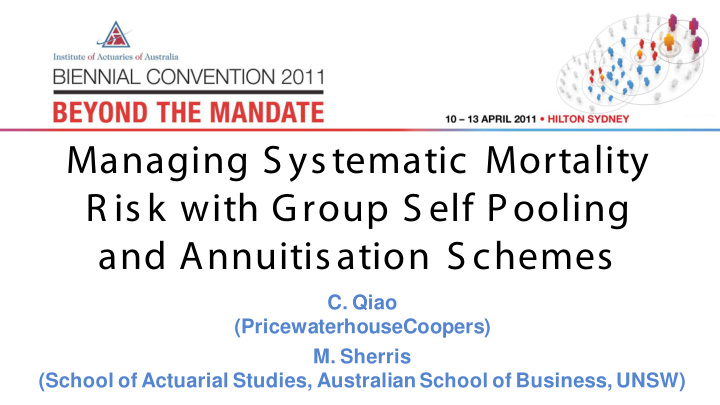



Managing S ys tematic Mortality R is k with Group S elf Pooling and Annuitis ation S chemes C. Qiao (PricewaterhouseCoopers) M. Sherris (School of Actuarial Studies, Australian School of Business, UNSW)
Introduction • Australia needs a retirement funding product that addresses longevity, to complement DC savings. (Cooper Review) • Annuity markets are extremely thin across the world, especially in Australia (Ganegoda and Bateman 2008) –Supply: Capital issues (Purcal 2006) and systematic risk –Demand: Bequest and below expectation yields (Friedman and Warshawsky 1990) –Demand: Low payments and high premiums (Mitchell et. al. 1999) • Pooling solutions such as Group Self-annuitisation schemes (GSA) are under consideration by DC funds.
Literature • Annuitisation is an optimal longevity hedge. (Yaari 1965; Davidoff et al. 2005) • GSAs – Pooling mechanism (Piggott, Valdez and Detzel 2005) – Adverse selection (Valdez, Piggott and Wang 2006) – Portfolio choice and utility gains (Stamos 2008) • Issues with existing literature – Systematic risk being borne by members – Payment amount declines and volatility rises over time, especially at extreme ages, due to dependence across ages – Reducing numbers in pools, in old ages, increases payment volatility
R es earch Objectives • Assess and improve GSA sharing –Gompertz-Makeham model used to generate extreme value survival times –Capture dependence across ages –Large pools –New cohorts –Address old age variability –Early recognition of expected future systematic improvements
Main Findings • GSA pooling mechanism under Piggott et al. 2005 give declining payments and high variability over time, due to dependence and systematic mortality improvements. • Solutions: –Pool size effect on idiosyncratic risk and the “lucky hump” volatility –Reduce old age variability through introduction of younger cohorts over time, rather than at the same time, sharing their mortality experience –Preemptive realisation of expected future systematic mortality improvements instead of waiting for them to eventuate
Methodology • Improved benefit sharing framework: –On contribution, the initial fund balance of the member is where x is the age for the i -th individual at time t , being a member of the pool for k years – The member's benefit payment at any given point in time is
Methodology • Each year, the member's fund is accumulated with interest and investment earnings. • For living members, the accumulated fund balance is then supplemented by the inheritance from members who perished
Improvement The relationship between benefit payments of successive periods can be represented by an adjustment factor reflecting the mortality experience of the pool, as well as systematic improvements that have taken place. compared to Piggott et al.
Improvement As an improvement on Piggott et al. 2005, future mortality improvements are shared before they eventuate. Instead of afterwards as in Piggott et al., where
Mortality Model • Stochastic GoMa model based on Schrager 2006 with the initial condition • Key model features: –Systematic dependence through time dynamic factors –Common improvements through the c factor –Extreme value distribution for aggregate survival times –Closed form annuity factors compatible the GSA pooling model
Pool S ize E ffect Simulation results for 10 Australian males at 5% interest, $100 initial contribution each. The grey bands indicate 95% simulation errors from 5000 simulations.
Pool S ize E ffect 1000 members. The “lucky hump” disappears to the right, and payments decline less. Volatility in old ages remains an issue.
Dynamic Pooling E ffect Introduce younger cohorts regularly, sharing their mortality experience. The “lucky hump” disappears, payment amounts decline less and variability in old ages is reduced.
E arly recognition of expected mortality improvements By recognising expected future systematic improvements before they arise, rather than in Piggott et al. where they are recognised only afterwards. The median payments no longer decline.
R eal Interes t R ates Under real interest rate of 2.69% (20 year historical average), the inflation adjusted benefit payments increase over time.
R eal Interes t R ates Introduce variability in the real interest rate through a Cox-Ingersoll-Ross model, the inflation adjusted benefit payments display increased variability.
S ummary of R es ults
Conclus ion The results show that • Idiosyncratic risk: increasing the pool size increases the amount and decreases the volatility of benefit payments received by GSA members. • Old age volatility: introducing new cohorts from younger cohorts on a regular basis reduces the volatility of benefit payments received by old members. • Systematic risk: Up front recognition of future mortality improvements makes the benefit payment amount more stable for GSA members as they are no longer overpaid initially. • Investment experience increases the volatility of benefit payments received by GSA members; but investment returns can be shared in a GSA, not in an ordinary annuity. • However, EVT issues point towards other solutions such as reinsurance. • It is also possible to hedge systematic risk through the financial market, such as through longevity bonds or securitisation.
Recommend
More recommend